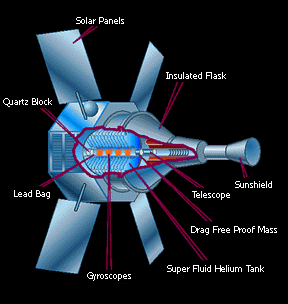Silence Please
"It's extremely difficult to test," says Everitt. That's why the experiment will be carried out in space where the rumblings of passing cars and noisy laboratories are absent. Even so, on the scale of gravitomagnetism, space is filled with a cacophony of unwanted noise. For example, the probe will sweep repeatedly through the Earth's magnetic field, generating currents and forces that could overwhelm the results. Somehow the spheres must be shielded from this field. And then there is the measurement itself. How can the orientation of the spheres be monitored with such precision without deflecting them in any way?
 Everitt and his team have spent more than two decades solving these problems. The best way to measure gravitomagnetism, Everitt says, is to use superconductivity; the phenomenon of zero resistance that occurs when certain materials are cooled below a critical temperature. When superconductors rotate, strange things begin to happen. In an ordinary conductor, the electrons in the material are dragged around as it rotates. In a superconductor, however, they get left behind, creating a current that generates a magnetic field. This magnetic field (known as the London moment after the German physicist who predicted it, Fritz London) is precisely aligned with the spin axis. Creating a London moment on each sphere is the key to the Gravity Probe B experiment.
Everitt and his team have spent more than two decades solving these problems. The best way to measure gravitomagnetism, Everitt says, is to use superconductivity; the phenomenon of zero resistance that occurs when certain materials are cooled below a critical temperature. When superconductors rotate, strange things begin to happen. In an ordinary conductor, the electrons in the material are dragged around as it rotates. In a superconductor, however, they get left behind, creating a current that generates a magnetic field. This magnetic field (known as the London moment after the German physicist who predicted it, Fritz London) is precisely aligned with the spin axis. Creating a London moment on each sphere is the key to the Gravity Probe B experiment.
The gyroscopes will spin in vacuum inside sealed chambers at the heart of the spacecraft. The gap between the spheres and the walls of the chambers will be only a few thousandths of a centimetre, so any expansion could ruin the results. The chambers will be made from fused quartz that expands very little when heated. "It's a very stable material," says Sasha Buchman, who is in charge of the gyroscope system.
The spheres will have to be almost flawless since any imperfections would create a torque that mimics the effect the researchers are trying to measure. Variations in density within each sphere must be kept below a few parts per million, thousands of times better than a typical ball bearing. Each must be electrically neutral so that no charge can build up which might swamp the results. And their surfaces must be polished to within 40 atomic layers of a perfect sphere.
The ideal material for the spheres is quartz, which can be polished with immense accuracy. The spheres will be so perfect that if they were the size of the Earth, the highest mountain would be only two metres tall. To create a London moment, the spheres will be coated with a layer of the metal niobium only 1000 atoms thick which will become superconducting when cooled below 4 kelvin.
